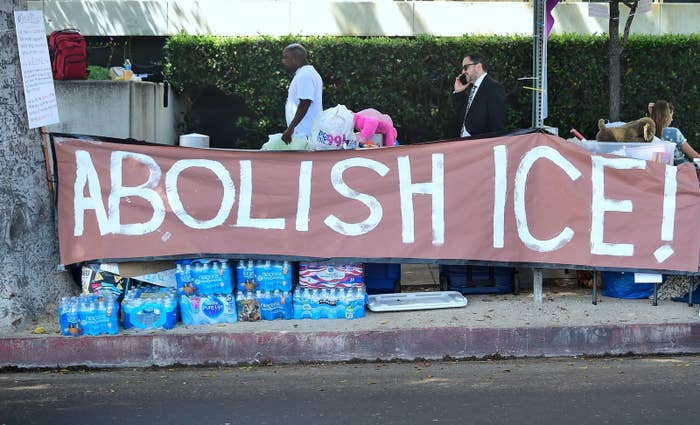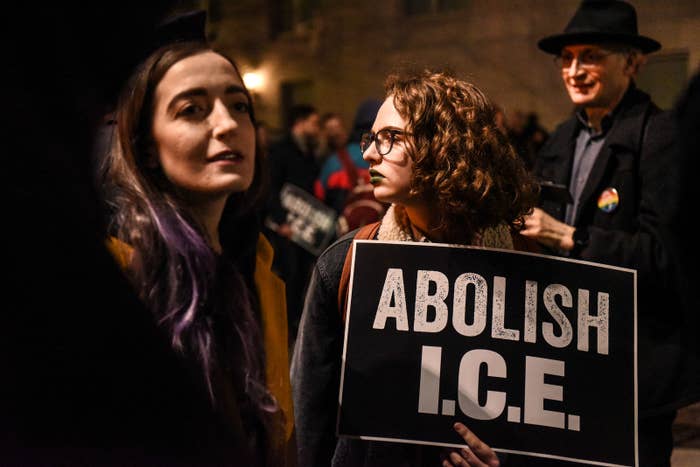
At first, the Abolish ICE movement seemed to follow a familiar pattern. One after another, under pressure from activists and the party’s left wing, Democrats laying the ground for presidential runs last summer came out in favor of tearing down and replacing the Immigrations and Customs Enforcement agency that patrols the interior of the country.
But months into the Democratic presidential primary, the activists behind Abolish ICE have been left frustrated, disappointed, and angry, according to interviews with eight local and national immigrant activists and Latinx groups. They feel used, they say, by the country’s most prominent Democrats — transformed into a hashtag to earn political points, and then cast aside just as quickly.
Talk of replacing ICE, or even of the agency’s problems, has all but disappeared from the Democratic campaign trail, and from Democrats’ political platforms. For all the work by activists to push abolishing ICE into the Democratic Party debate, the idea was starkly unpopular with voters: By late last summer, an AP–NORC poll showed only a quarter of Democrats backed the idea. The catchphrase that launched the movement, “Abolish ICE,” has been rejected entirely by the presidential contenders that once seemed to back it. The only place it has appeared: relentless Republican attack ads.
Many immigration activists worry that the flood of attention from top Democrats last summer, which came with few specifics and little consultation with grassroots groups, may have actually hurt their movement — a push for reforming ICE that began during Barack Obama’s presidency.
“It’s a little harmful,” said Miguel Andrade, a spokesperson for Juntos, a Latinx activist group in Philadelphia. “Everybody was using it as the big hot topic or issue, but nobody is putting the model forward of what that means, or the possibilities of what that looks like.”
“When there’s a void of information,” Andrade said, “the right is going to fill it with their rhetoric.”
The trajectory of Abolish ICE has become a cautionary example for activists looking to push their priorities onto 2020’s sprawling Democratic field — and for Democrats looking to score political points by embracing new progressive priorities.
Since long before any candidates actually announced they were running for president, a cascade of Democratic presidential hopefuls have made news by backing positions that once sat squarely on the party’s far-left edge — from Medicare for All to the Green New Deal to expanded voting rights for felons. In the case of Abolish ICE, the issue faded away almost entirely in the face of its dismal polling.
So far, Democrats’ other progressive priorities haven’t faced the same fate — Medicare for All and voting rights for felons are broadly popular. But as Republicans and interest groups have ratcheted up attacks on Medicare for All, many Democrats have begun to temper their calls to adopt a single government-based system in favor of arguments for slower, more nuanced approach. And some polls show that the Green New Deal, another slogan quickly embraced by Democrats, is wildly unpopular among Republicans, and divisive for Democrats.
The rise and fall of Abolish ICE among presidential hopefuls also points to a Democratic Party that has struggled to figure out its message on immigration — angering activists while making little headway on solutions.
“It's safe to say a lot of folks in immigrant rights, especially our wing of it, are very dissatisfied with what any Democrat has been saying,” said Juan Prieto, a communications strategist for the California Immigrant Youth Justice Alliance. “The Democrats aren’t bold enough for vision. They’d rather fight fire with a water gun.”

The push to abolish ICE surged onto the national stage after Rep. Alexandria Ocasio-Cortez won her primary — in part by hammering her incumbent opponent for voting to establish ICE in 2002, and calling for the agency to be eliminated altogether.
Top Democrats eyeing presidential runs took notice. When Sen. Kirsten Gillibrand was asked in June what the Democratic Party would do with Ocasio-Cortez’s push to “get rid of ICE,” Gillibrand said, “Well, I agree with it. I don’t think ICE today is working as intended.” She added: “I believe you should get rid of it, start over, reimagine it, and build something that actually works.”
Days later, Sen. Elizabeth Warren called for “replacing ICE with something that reflects our values” in a Facebook post. Sen. Kamala Harris quickly announced she wanted to “reexamine” ICE, saying, “probably think about starting from scratch,” but distanced herself from those calling to “abolish” the agency. Sen. Bernie Sanders tweeted that he wanted to “abolish the cruel, dysfunctional immigration system,” which he said would mean “restructuring” ICE.
But just as rapidly as Democrats picked up progressives’ rallying call on ICE, Republicans did too. The warning that Democrats wanted to “abolish ICE” appeared in a drumbeat of attack ads throughout the fall midterm campaign that painted the party as weak on immigration and border security. Democrats, with popular opinion turning, began to keep the issue at an arm’s length.
Almost a year later, as they vie for the Democratic nomination, Gillibrand, Harris, Warren, and Sanders have, for the most part, simply stopped talking about it at all. On the campaign trail, they stick to much more popular immigration issues, like ending child separation at the border.
At the same time, deaths in ICE custody and an increase in pregnant women having miscarriages because of alleged medical negligence in ICE custody continue to raise questions about the agency’s treatment of migrants.
Representatives for Harris and Sanders did not respond to questions from BuzzFeed News about their stance on ICE, including details of what they hoped to replace ICE with. Gillibrand’s campaign offered details on her position to break up ICE — but they were quick to claim that Gillibrand did not say "abolish.” She did, in a tweet last summer.
Warren’s campaign has focused heavily on policy, offering detailed plans for a dozen different issues. But asked if she had a plan to “replace” ICE, as she’d called for last summer, her campaign offered only this quote from Warren: “We need an immigration system that is consistent with our values. An immigration system that can't tell the difference in the threat posed by criminals or terrorists and a 9-year old girl needs to be rebuilt from top to bottom.”
To Sarahy Garcia, an immigration activist in Texas who protested in favor of abolishing ICE, the silence from 2020 Democrats on ICE has been deafening.
“I’m very disappointed in the fact that no one is openly talking about this,” Garcia said. “They dance around it, they say things like, ‘It’s inhumane,’ ‘Families shouldn’t be separated,’ but they’re not offering anything tangible. They don’t say anything about ICE. They don’t mention ICE.”
“They don’t say anything about ICE. They don’t mention ICE.”
Garcia enthusiastically backed Sanders in 2016. But at April’s "She the People" conference in Houston for women of color, Garcia watched presidential candidate after presidential candidate take the stage without mentioning ICE — an agency Garcia believes is “rogue,” unaccountable to anyone. She left feeling “heartbroken.”
“I just don’t understand how they can be quiet about it,” Garcia said.
The way that 2020 Democrats spoke about eliminating or reforming ICE, with little substance or even background about the agency’s history, left an opening for Republicans to recast the conversation and turn people against the idea of abolishing ICE, some activists said.
“Without being able to back it up with facts with what it actually means, it’s very easy for the opposition to use that as a form of attack,” said Andrade of Juntos. Andrade watched the same thing happen with the idea of “sanctuary cities,” a concept co-opted by President Trump and his allies to paint liberal cities that refused to cooperate with ICE as lawless and dangerous.
Only one national politician, Andrade said, talks about abolishing ICE in a way that communicates the complexities of the issue: Ocasio-Cortez. “She’s one of the few ones that when I hear her talk, I think, ‘You understand,’” Andrade said. “I think it’s her ability to actually communicate with on-the-ground groups.”
Part of the problem, advocacy groups say, was that the politicians didn’t do enough outreach to immigrant groups before — or after — they came out in favor of ICE reforms.
Two immigrant advocacy groups have published Abolish ICE platforms with details on what it would look like to actually eliminate the agency. But both groups, Mijente and the California Immigrant Youth Justice Alliance, say none of the candidates who have said they want to abolish or restructure ICE have come to them to talk about the issue specifically, though Julián Castro’s and Sanders’ campaigns reached out to Mijente for more general conversations.
Mijente wrote their Abolish ICE platform last year because they saw “this sort of upsurge of focus on the idea that ICE should be abolished” from Democrats, and the need for a more robust explanation of what that actually means in the absence of concrete plans from politicians, said Tania Unzueta, policy director for Mijente.
Activists were frustrated by how quickly Democrats backtracked on ICE — saying, as Gillibrand rapidly did, that they didn’t want to eliminate the agency altogether. Focusing on renaming ICE or redistributing duties, they argue, misrepresents their position and doesn’t address their concerns about the agency’s treatment of immigrants.
“The literal definition of abolition is to get rid of a law or practice that is harmful to society,” said Prieto of the California Immigrant Youth Justice Alliance. “That is what we mean when we say we want to abolish ICE, that ICE is harmful to society and we need to get rid of it. Not restructure it, not rename it, not paint it blue and put a Democrat stamp on it.”

On the campaign trail, Democratic voters often ask presidential hopefuls about immigration, including concerns about comprehensive reform and family separations. But questions about ICE, the hot-button issue of last summer, are largely absent.
Democrats are running up against the political reality that immigration reform remains a tricky political tightrope, especially in some key swing states. Americans broadly support policies like offering pathways to citizenship for undocumented immigrants brought into the country as children, but they also tend to favor border security measures and banning sanctuary cities.
Only one Democrat running for president, Castro, has so far come out with a detailed immigration plan, which includes a vision for ICE. Castro said he wants to “reconstitute” ICE by splitting the agency in half, handing over some powers to other agencies. Gillibrand talked about a similar idea in an interview with an upstate New York newspaper in September and while campaigning in Iowa in January.
In the Senate, Harris introduced a bill last year that would increase oversight of ICE facilities and halt funding to build new detention centers. But it is not something she talks about as she campaigns.
“The fact is that a lot of these campaigns, and it has happened many times before, they sort of blurt out and put out a statement — that they support comprehensive immigration reform, that they support the DREAM Act — and they think that’s what’s going to get the support from immigrant rights groups, or even voters who actually care about the issue,” said Erika Andiola, chief advocacy officer for RAICES. “But that’s not enough. And part of why they do that is because they’re not connecting to groups who have been doing this work for so long.”
Mijente wants to see candidates committing to a moratorium on deportations, an end to all types of immigration detention, and for border patrol and immigration agents to be humanitarian workers instead of a law enforcement agency. For the California Immigrant Youth Justice Alliance, getting rid of ICE is part of a wider movement for prison abolition.
Abolishing ICE as just a starting point for immigration reform, activists said, but they see supporting it as a sign of whether or not they could be up against a Democratic president who carries out a similar immigration agenda to the Obama administration. Though Obama offered some reprieve for young undocumented people in the form of Deferred Action for Childhood Arrivals, or DACA, he also carried out some 2 million deportations during his eight years in the White House.
“Part of what we have been trying to do over these last four years is to try to communicate to Democrats that right now is a chance to go beyond the Obama years,” said Mijente’s Tania Unzueta. “We had a lot of criticism of how Obama handled immigration enforcement, and it wouldn’t be a good scenario if, after Trump, we go back to Obama-level policies.”
She said that while she acknowledges that it’s difficult to talk about abolishing a law enforcement agency during a presidential election, she hopes candidates can at least come up with concrete plans for ICE that look to “diminish its harm, take away its power, take away its funding, so that maybe one day we can abolish it.”
Garcia, the Texas activist, said she’s waiting for a presidential candidate to offer a vision of what abolishing ICE might look like — something that she hopes might turn the tide of public opinion.
“I honestly think that for most Americans, if you would just explain to them what ICE is, most Americans would be on board. For the most part, people are good,” Garcia said. “Right now, the people don’t understand what abolishing ICE is.”
CORRECTION
Gillibrand’s campaign said “she did not say ‘abolish’” in relation to a comment the senator made about the Abolish ICE movement. A previous version of this story misquoted the campaign’s statement.

